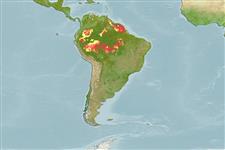Classification / Names
Common names | Synonyms | Catalog of Fishes (gen., sp.) | ITIS | CoL | WoRMS | Cloffa
Environment / Climate / Range
Ecology
Freshwater; benthopelagic; pH range: 5.5 - 7.5; dH range: ? - 20. Tropical; 22°C - 29°C (Ref. 2059), preferred ?
South America: Mana River basin.
Size / Weight / Age
Maturity: Lm ? range ? - ? cm
Max length : 20.0 cm TL male/unsexed; (Ref. 12225); 25.0 cm (female); max. published weight: 185.00 g (Ref. 12225); max. published weight: 185.00 g
Adults occur in large numbers at the entrance of creeks where the bottom is sandy or muddy and the current is fast or slow (Ref. 27188). Juveniles occur in calm, shallow waters, in counter current zones or in the shelter of plants (Ref. 12225). Omnivorous. They possess enzymes which enable them to digest chitin, pectin, hemicellulose and mucopolysaccharides. Individuals are easily captured with hook and line with small hooks (Ref. 27188). Reproduction takes place from December to June (Ref. 12225). Distinct pairs breed on densely grown weedy places (Ref. 205). Known among aquarists, this fish is considered turbulent in captivity (Ref. 27188).
Life cycle and mating behavior
Maturity | Reproduction | Spawning | Eggs | Fecundity | Larvae
Distinct pairs breed on densely grown weedy places (Ref. 205).
Planquette, P., P. Keith and P.-Y. Le Bail, 1996. Atlas des poissons d'eau douce de Guyane. Tome 1. Collection du Patrimoine Naturel Volume 22, MNHN, Paris & INRA, Paris. 429 p. (Ref. 12225)
IUCN Red List Status (Ref. 115185)
CITES (Ref. 94142)
Not Evaluated
Threat to humans
Harmless
Human uses
Aquarium: commercial
More information
ReferencesAquacultureAquaculture profileStrainsGeneticsAllele frequenciesHeritabilityDiseasesProcessingMass conversion
Tools
Special reports
Download XML
Internet sources
